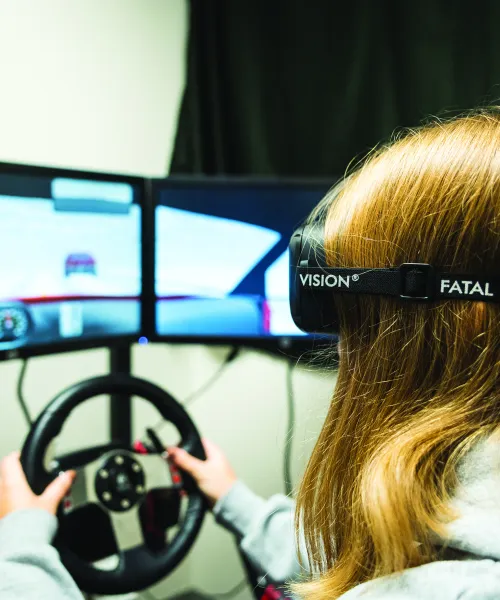Data Driven
“Dr. Forrest Toegel in our Psychology Department has taken a novel approach to teaching what is typically considered a rather dry course - research methods (Psychological Research II: Experimental Design and Methodology),” said Department Head Adam Prus. “Generally, this is just a textbook course where students learn about between-groups designs, Latin Square, quasi-experimental designs, etc. Forrest has made this a hands-on class where students have been using a professional driving simulator and assessing performance on each other under different conditions. Not only is this a more engaging way to teach this topic, but they have been collecting actual experimental data that could potentially be presented to professionals.”
There was nothing dry about the course when Northern Magazine staff visited. Students were abuzz with activity in a narrow hallway in Weston Hall. Master’s student and Teaching Assistant Carson Yahrmarkt '21 BS was changing the settings on a SimuRide driving simulator from “Bendy Roads with Falling Boulders” to “Changing Lanes and Passing on a Snowy Day.” Wearing alcohol visual impairment goggles, students from one group got behind the wheel and another group conducted field sobriety “walk and turn” tests—with a student walking nine heel-to-toe steps forward and back along a yellow and black striped strip of tape in the middle of the hallway floor. It’s the same test used by road patrol police officers. In both walking and driving tests, students donned goggles simulating two levels of impairment: .06 Blood Alcohol Content (BAC) – less than the legal limit in Michigan—and .25 BAC. They also used clear goggles with no BAC and no goggles at all. They recorded observations and data and compared their findings across goggle variations, days and other factors.
“These experiments are fun, but the real reason we’re doing this is to give the students hands-on experience with psychology research methods and allow them to practice different methods of collecting data,” said Toegel. “It’s one thing to teach with PowerPoint in a lecture hall, but it may be much better and more meaningful for students to actually employ the research methods and analyze the data that students and their classmates collect.”
The class also designs a questionnaire which is answered by all the students, to see if other factors affected their driving or sobriety test — questions such as “How many winters have you driven in the U.P.?” or “How much caffeine do you consume per day?” At the end of the semester each student designs their own data analysis poster presentation project, such as “Men vs. Women: Who steps off the line more often?”
Graduate student and TA Mackenzie Baranski produced a poster that she plans to present at the Mid-American Association for Behavior Analysis Conference in St. Louis, Mo. It includes some surprising results. “What’s interesting is that there were not significant differences in collisions or rate of speed between the control and impaired groups, which isn’t what you would expect,” she said. “We have ideas as to why that is. In the line test, your whole body and head is moving, whereas with the simulator, you are just sitting stationary and may not be feeling the effects as much.”
It was a wonderful opportunity to learn new things and how I can now implement some of what I learned into the real-world experiences that will come along in life. Being able to utilize Excel has also been very beneficial. Now that I know how to do a lot of different functions with it, I know that it is something that I will be able to successfully use in the future.
Toegel added that “it’s not very often that a university has this technology available. I came from Johns Hopkins and they just got one recently. It’s a very rare opportunity, and our students and faculty are fortunate to have it.” He has taught the course two times and is in the process of analyzing data of his own: namely, whether the hands-on research opportunities offered in his class contribute to student success. Judging from student comments, such as that in orange above, it most certainly does.

